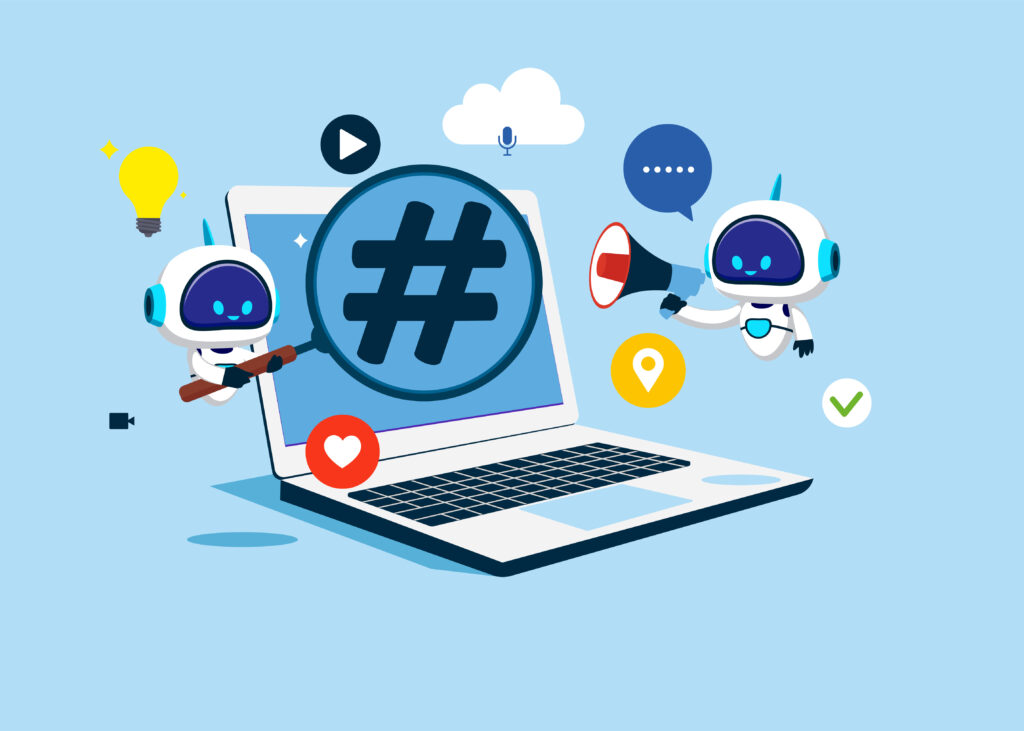Social media still seems like a relatively new concept, but the hashtag (#) has existed for over 16 years. In 2007, Chris Messina proposed using the pound sign to track conversations related to a conference. A few months later, users started using hashtags to track the spread and coverage of the San Diego wildfires, using none other than #sandiegowildfire.
The rest is history. Hashtags became popular across nearly all social media platforms and grew into our daily vocabulary. Most young children recognize this sign as a hashtag rather than a telephone button used to connect callers to specific departments.
However, a lot has changed in the past few decades. While hashtags are still common, some wonder if they are even necessary. Social media algorithms and search tools are so advanced — do people even need to use these tags? It’s time to modernize your social media know-how. Here’s how to maximize your use of hashtags in 2023.

What Is a Hashtag and How Do You Use It?
A hashtag is a word or phrase that you attach to your posts to make them more findable. Originally, hashtags were used to group conversations so people could see content around a specific topic. Someone can tweet about the latest #90DayFiance episode without worrying about #MNF (Monday Night Football) posts clogging their feeds.
Brands and influencers use hashtags to increase their visibility. People can follow specific hashtags on Instagram, so someone who follows #Waderlust can see posts from travelers, influencers, and tourism brands who use that tag. These tags can be added to the end of posts so they don’t distract from the main content.
In recent years, social influencers and brands have claimed that hashtags have lost their power. They are no longer useful for getting noticed, and they often distract users from the actual content. For example, if you write, “December is a great time for buying a car, learn why in our latest blog post. #Carbuying,” influencers claim that the hashtag wouldn’t be relevant because the post would show up for someone searching the phrase “buying a car.” The focus is more on search intent rather than the hashtag use itself.
The reality of hashtag use is somewhere in the middle. These signs are used across Twitter, Instagram, TikTok, LinkedIn, and other social platforms. However, so many people misuse them that they seem useless. The key is to be strategic with your hashtag use to maximize its effectiveness. Here are a few best practices to follow.
The Age of Hashtag Stuffing Is Over
The first thing you need to stop doing when creating social media posts is packing them with hashtags. There was a time when people were encouraged to add more than a dozen tags to their content – with some brands even making separate comments on their posts to add more hashtags. The idea was that the more hashtags you used, the more people would find and engage with your post. However, in the modern social era, this isn’t true.
Research shows that tweets with one to two hashtags have a 55% higher chance of getting retweeted than those without. However, tweets with more than two hashtags have 17% less engagement. Engagement rates continue to drop the more tags you use.
Why is this? There are multiple reasons. First, overstuffing hashtags distracts from the content and can potentially make your posts look like spam. This makes users less likely to engage with or share them. Next, while adding multiple hashtags might increase your reach, they won’t necessarily increase your engagement if the content isn’t relevant. It can actually drive your engagement rate down because you are reaching more people who don’t like, comment, or share. Lower engagement rates lead to lower exposure by the algorithm, so fewer people see your posts in the long run.
Stop Trying to Compete With Global Hashtags
There is good news if you chronically overstuff your posts with hashtags: finding irrelevant tags to eliminate is easy. For example, #love has more than two billion tags on Instagram. It is highly unlikely that your post will stand out amongst the billions of other images, videos, profiles, and reels that use it. Other common hashtags include #instagood at 1.3 billion and #fashion at 943 million.
Social media is entering an era where effective hashtag use focuses on user intent — much like keyword selection in SEO. It is better to use a handful of highly relevant hashtags to engage with users instead of trying to use the most common and competitive options.
Furthermore, you don’t want to risk creating engaging content that could potentially get lost in a sea of global competitors. If you post a reel with #ChevyDealer, you are competing with other dealerships across the United States. However, if you hone your hashtag to make it more unique and local, you could potentially reach relevant audiences who are actually close to your business.
Do Your Hashtag Research
As you create social media content, you need to build hashtag research into your development process. Really spend time learning about different hashtags, learning about your options, and looking for red flags in your content. Use this checklist to make sure your hashtags are useful and relevant.
- Avoid banned hashtags. You might be surprised by some of the tags that Instagram asks users to avoid. These are seen as inappropriate or overly spammy.
- Don’t choose the most popular tags. This is similar to your paid search campaigns. Look for lesser-used tags that are more relevant to your customers.
- Don’t go too niche. It is possible to overcorrect to the point where you use hashtags that no one follows. Your research should help you strike a balance.
- Check the context of the posts. Certain seemingly harmless words and phrases have been co-opted by racists, porn creators, and other niche groups. You might send an unwanted message to followers by using these tags.
As you research different hashtags, change up the ones you use. This will allow you to test which tags work and which ones aren’t as effective. Using a variety of hashtags in your posts will also prevent you from accidentally spamming the groups of people who follow those specific tags.
Social Media Is Louder Than Ever
It’s not that hashtags themselves have changed meaningfully over the past few years. Instead, social media use as a whole has evolved, which has impacted how the average user interacts with hashtags.
Look at how Instagram has grown over the past decade. In 2013, there were only 110 million users nationwide. In 2023, there will be 2.5 billion users. That is a third of the world’s population! While there are plenty of corporate accounts, spam bots, and duplicate profiles included in the 2.5 billion, this data still highlights how much noisier Instagram has become in recent years. TikTok has also seen astronomical growth rates, which makes it harder to stand out amongst content creators than in years past.
A few years ago, your hashtag helped users discover your content. You could reach and win potential followers, growing your own following in the long run. However, it is much harder to get noticed in today’s social platforms — and even harder to convert people into followers of your brand.

Celebrities Are Exempt From Hashtags
As you look at some of the most popular social media posts in recent years, you might notice that fewer famous people use hashtags. This could lead you to believe that the era of hashtags is over. However, the reality is that famous people already have larger followings. They don’t need to reach more people in hopes of increasing their engagement.
For example, Beyonce has 317 million followers. Almost anything she posts reaches millions of users, gets shared countless times, and inevitably gets picked up by gossip sites and news outlets. She doesn’t need to use hashtags, so more people find her content.
Unfortunately, you aren’t Beyonce. You still need to explore hashtag opportunities to reach new potential customers and drive traffic to your website and physical locations.
Compare Your Hashtag Use to Your Target Audience
The changing use of hashtags is actually a good thing for brands nationwide. People are getting smarter and more strategic with how they use these tools, rather than mass-blasting their followers with dozens of hashtags that are forced into every post. As you adjust your social media content process, you might decide to use certain hashtags to reach new audiences while using limited tags (or none at all) to address your current followers and potential repeat customers.
Focus on user intent with your hashtag use and content development. Ask: who needs to see this post, and what action will they take from it? Creating meaningful social media content that genuinely helps your followers will be more impactful than any hashtag research you track down. The goal of these efforts isn’t to find a magical hashtag that boosts your reach but rather to develop meaningful relationships with the people who engage with your brand online.
Work With a Partner That Keeps Up With Social Media Trends
Hashtag use has evolved in recent years, which means you might harm your promotional efforts if you are still stuffing your posts with #love and #Instagram. Instead of trying to keep up with changing trends yourself, turn to the experts who can manage your pages for you. At J&L Marketing, our job is to keep up with the latest opportunities to help clients maximize their reach, engagement, and ROI.
We are good at what we do. The Facebook average for click-thru rates is 0.8%. We more than triple that and boast a 2.8% click-thru-rate average across our clients. Our social media team can make your content more visible and engaging so you can drive results.
Reach out to our experts today and tell us about your social media problems. We can review your hashtag use and content creation to develop a successful plan moving forward.



